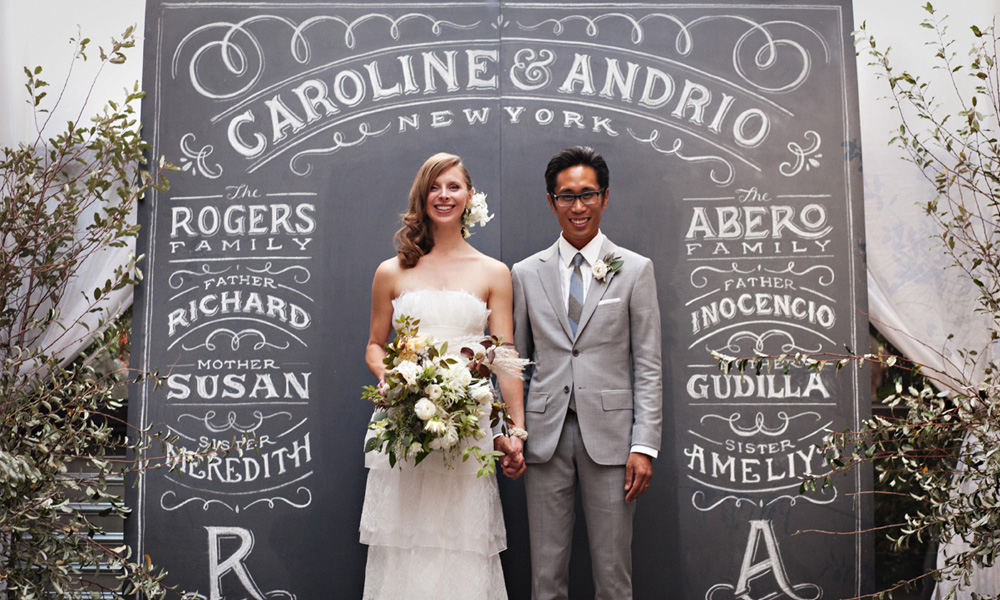
How did you get your start in design? What has shaped your career path?
I started out studying Communication Design at the University of North Texas. I never once consider changing my major, as I continually found it fascinating and still do! My career path has been greatly shaped by close relationships in my life—not necessarily networking or “hustling”. At each stage of my young career, I can clearly see the people who have supported me and sought my personal and professional growth as a designer and friend. It was a friend of a friend who gave me my first job at SpotCo in NYC designing Broadway show posters. It was a dear friend and co-worker from SpotCo who recommended me to Louise Fili. And it was an entire community of supportive friends in Brooklyn who encouraged me to pursue something as seemingly silly as chalk. It certainly takes a village, and for this I am thankful.
Tell us about your experience working under Louise Fili.
Working for Louise Fili was one of those dreams that I never thought would come true in a million years. But, then it did. I would find myself constantly in awe of all her work—the beautiful books on the bookshelf, food packaging on display in her conference room, vintage finds scattered throughout the studio. What I love most about Louise is that she has an entire career’s worth of incredible work, yet she balances family life and personal passions so well. At the studio, I was mainly responsible for working with clients on existing jobs, not creating new work. And since I was used to creating type from scratch from my days at SpotCo, I became concerned that I would lose those developing skills. I simply didn’t want to become rusty—I needed to get better. And when the stars aligned one night in 2009, it seemed that chalk was the medium that would allow me to do that.
I saved the most obvious question for the middle: why chalk?
It’s not as if I sat down one day to figure out what would be the next cool medium. Not at all. It was a very personal, unique journey that led me to the world of chalk lettering. The first time I ever picked up a piece of chalk in this way was a few years ago. My friends were having a themed housewarming party—The Great Gatsby—in Brooklyn and I stopped by with a friend from college. There was a big chalk wall with several quotes scribbled all over it, which I was really drawn to. To the side, they had a smaller, blank chalk wall. My friend said, “You’re artsy, right? Why don’t you draw something? Here’s a piece of chalk.” I turned to the friend who I was with and said, “Let’s draw the word ‘Brooklyn’.” He started on the “B” and I started on the “n” and we were going to meet in the middle, but in a few minutes, I was already on to the “r” and he was still drawing the “B”. We were laughing.
I didn’t think anything of our drawing, but someone came up and asked, “Did you all just do that?” Others started coming over and asking us to take their picture in front of it. My friends all said, “I didn’t know you could do that!” Well, I didn’t know I could do that either. It ended up becoming the photo wall for that party and after that, everyone uploaded their pictures to Facebook. For the next several parties, I would come over beforehand to draw other themed backdrops. I did this for about a year in complete obscurity—it was just “our thing”—something that was birthed out of my community of friends here in Brooklyn and something that emerged out of celebration.
Without giving away your secret recipe – can you describe a bit about your creative process when developing a large-scale chalk piece? For example, how much is planned ahead of time vs. inspired on the spot?
When I first started doing the chalk pieces of my friend’s parties, I wouldn’t sketch at all. It was 100% on the fly. But, show me a client who will let you do that! Obviously, my process has had to adapt. I typically submit one rough sketch, and my clients usually trust me enough to come in and create an installation based on that—knowing that it will be much tighter and more detailed. I’d say 60% is planned in advance, 40% once I get going on the chalkboard. Other than that, almost nothing about my process has changed. I still use the same crappy chalk, an old rag and a sewing tape measure. It’s important to me to keep the purity of the process—no projectors.
You’re a native Texan and Houstonian – how have your roots informed your design thinking? What inspired you here?
Yes, I am a proud Houstonian and couldn’t be more excited to come home and share my story. I come from a line of farmers and migrant workers from South Texas in the Rio Grande Valley—people who lived simple (not easy!) lives and had to make somethings out of nothings. My Grandmother would make beautiful dresses out of potato sacks; her mother would make intricate flower arrangements out of painted Mexican dough. My family’s history in the Lone Star State has been an incredible inspiration to me—they were gifted at taking simple materials and creating unexpected beauty out of them.
—
If you’d like to ask Dana a question in person, be sure to register now for her speaking appearance at Domy Books on Thursday, September 6. Spots are filling up fast, so don’t wait!
Click here to register